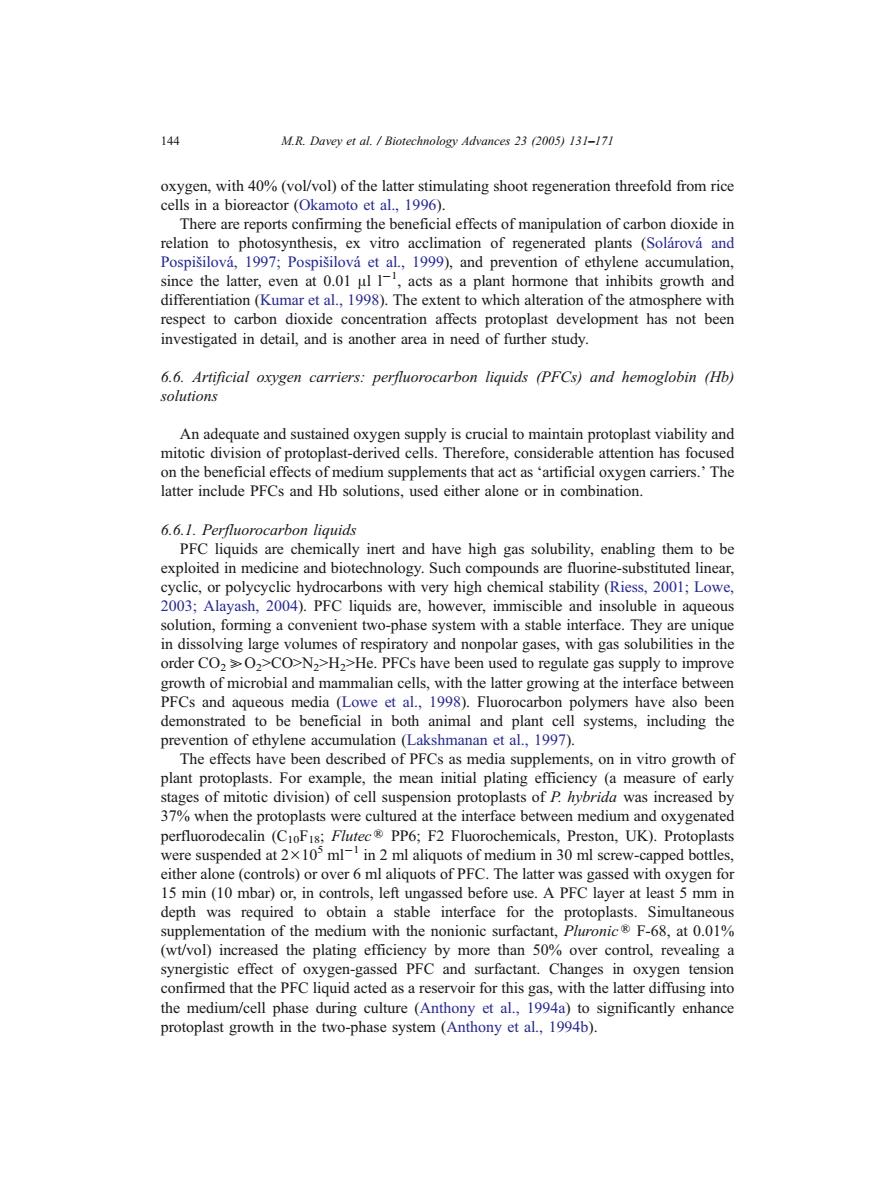正在加载图片...

144 M.R.Davey et al.Biotechnology Advances 23 (2005)131-171 oxygen,with 40%(vol/vol)of the latter stimulating shoot regeneration threefold from rice cells in a bioreactor(Okamoto et al.,1996). There are reports confirming the beneficial effects of manipulation of carbon dioxide in relation to photosynthesis,ex vitro acclimation of regenerated plants (Solarova and Pospisilova,1997;Pospisilova et al.,1999),and prevention of ethylene accumulation, since the latter,even at 0.01 ul I-,acts as a plant hormone that inhibits growth and differentiation (Kumar et al.,1998).The extent to which alteration of the atmosphere with respect to carbon dioxide concentration affects protoplast development has not been investigated in detail,and is another area in need of further study. 6.6.Artificial oxygen carriers:perfluorocarbon liquids (PFCs)and hemoglobin (Hb) solutions An adequate and sustained oxygen supply is crucial to maintain protoplast viability and mitotic division of protoplast-derived cells.Therefore,considerable attention has focused on the beneficial effects of medium supplements that act as'artificial oxygen carriers.'The latter include PFCs and Hb solutions,used either alone or in combination. 6.6.1.Perfluorocarbon liquids PFC liquids are chemically inert and have high gas solubility,enabling them to be exploited in medicine and biotechnology.Such compounds are fluorine-substituted linear, cyclic,or polycyclic hydrocarbons with very high chemical stability (Riess,2001;Lowe, 2003;Alayash,2004).PFC liquids are,however,immiscible and insoluble in aqueous solution,forming a convenient two-phase system with a stable interface.They are unique in dissolving large volumes of respiratory and nonpolar gases,with gas solubilities in the order CO2O2>CO>N2>H2>He.PFCs have been used to regulate gas supply to improve growth of microbial and mammalian cells,with the latter growing at the interface between PFCs and aqueous media (Lowe et al,1998).Fluorocarbon polymers have also been demonstrated to be beneficial in both animal and plant cell systems,including the prevention of ethylene accumulation (Lakshmanan et al.,1997). The effects have been described of PFCs as media supplements,on in vitro growth of plant protoplasts.For example,the mean initial plating efficiency (a measure of early stages of mitotic division)of cell suspension protoplasts of P hybrida was increased by 37%when the protoplasts were cultured at the interface between medium and oxygenated perfluorodecalin (CioFIs;Flutec PP6;F2 Fluorochemicals,Preston,UK).Protoplasts were suspended at 2x10>ml-in 2 ml aliquots of medium in 30 ml screw-capped bottles, either alone(controls)or over 6 ml aliquots of PFC.The latter was gassed with oxygen for 15 min (10 mbar)or,in controls,left ungassed before use.A PFC layer at least 5 mm in depth was required to obtain a stable interface for the protoplasts.Simultaneous supplementation of the medium with the nonionic surfactant,Pluronic F-68,at 0.01% (wt/vol)increased the plating efficiency by more than 50%over control,revealing a synergistic effect of oxygen-gassed PFC and surfactant.Changes in oxygen tension confirmed that the PFC liquid acted as a reservoir for this gas,with the latter diffusing into the medium/cell phase during culture (Anthony et al.,1994a)to significantly enhance protoplast growth in the two-phase system(Anthony et al.,1994b).oxygen, with 40% (vol/vol) of the latter stimulating shoot regeneration threefold from rice cells in a bioreactor (Okamoto et al., 1996). There are reports confirming the beneficial effects of manipulation of carbon dioxide in relation to photosynthesis, ex vitro acclimation of regenerated plants (Sola´rova´ and Pospisˇilova´, 1997; Pospisˇilova´ et al., 1999), and prevention of ethylene accumulation, since the latter, even at 0.01 Al l1 , acts as a plant hormone that inhibits growth and differentiation (Kumar et al., 1998). The extent to which alteration of the atmosphere with respect to carbon dioxide concentration affects protoplast development has not been investigated in detail, and is another area in need of further study. 6.6. Artificial oxygen carriers: perfluorocarbon liquids (PFCs) and hemoglobin (Hb) solutions An adequate and sustained oxygen supply is crucial to maintain protoplast viability and mitotic division of protoplast-derived cells. Therefore, considerable attention has focused on the beneficial effects of medium supplements that act as dartificial oxygen carriers.T The latter include PFCs and Hb solutions, used either alone or in combination. 6.6.1. Perfluorocarbon liquids PFC liquids are chemically inert and have high gas solubility, enabling them to be exploited in medicine and biotechnology. Such compounds are fluorine-substituted linear, cyclic, or polycyclic hydrocarbons with very high chemical stability (Riess, 2001; Lowe, 2003; Alayash, 2004). PFC liquids are, however, immiscible and insoluble in aqueous solution, forming a convenient two-phase system with a stable interface. They are unique in dissolving large volumes of respiratory and nonpolar gases, with gas solubilities in the order CO2JO2NCONN2NH2NHe. PFCs have been used to regulate gas supply to improve growth of microbial and mammalian cells, with the latter growing at the interface between PFCs and aqueous media (Lowe et al., 1998). Fluorocarbon polymers have also been demonstrated to be beneficial in both animal and plant cell systems, including the prevention of ethylene accumulation (Lakshmanan et al., 1997). The effects have been described of PFCs as media supplements, on in vitro growth of plant protoplasts. For example, the mean initial plating efficiency (a measure of early stages of mitotic division) of cell suspension protoplasts of P. hybrida was increased by 37% when the protoplasts were cultured at the interface between medium and oxygenated perfluorodecalin (C10F18; FlutecR PP6; F2 Fluorochemicals, Preston, UK). Protoplasts were suspended at 2105 ml1 in 2 ml aliquots of medium in 30 ml screw-capped bottles, either alone (controls) or over 6 ml aliquots of PFC. The latter was gassed with oxygen for 15 min (10 mbar) or, in controls, left ungassed before use. A PFC layer at least 5 mm in depth was required to obtain a stable interface for the protoplasts. Simultaneous supplementation of the medium with the nonionic surfactant, PluronicR F-68, at 0.01% (wt/vol) increased the plating efficiency by more than 50% over control, revealing a synergistic effect of oxygen-gassed PFC and surfactant. Changes in oxygen tension confirmed that the PFC liquid acted as a reservoir for this gas, with the latter diffusing into the medium/cell phase during culture (Anthony et al., 1994a) to significantly enhance protoplast growth in the two-phase system (Anthony et al., 1994b). 144 M.R. Davey et al. / Biotechnology Advances 23 (2005) 131–171��